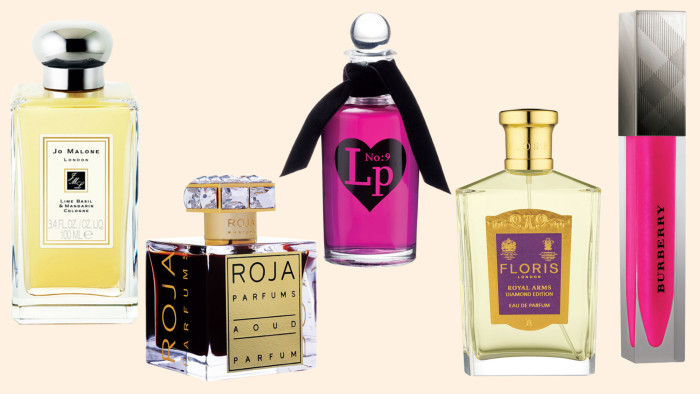British beauty means business

Roula Khalaf, Editor of the FT, selects her favourite stories in this weekly newsletter.
For an industry that is based on building confidence, the British beauty business has always suffered from low self-esteem.
The £17bn industry, which employs 1m people in the UK and is forecast to grow 16 per cent by 2016 (according to Ernst & Young), has, ironically, long been seen as the plainer younger sibling of fashion. As facialist Amanda Lacey says, “Fashion has been the bigger sister, and beauty has been pushed to the bottom of the pile.”
This may be about to change. On July 17, Cosmetic Executive Women UK, a philanthropic organisation that promotes women in the industry, is hosting a House of Commons reception for 140 MPs, peers and industry leaders, entitled The Shape of Things to Come – The Importance of the UK Cosmetics Sector.
“People were not aware of the size of the contribution of beauty business,” says Carol Bagnald, commercial director at HSBC, which is co-hosting the event. “We have a fund for £5bn earmarked for small and medium enterprises, mainly for new UK beauty brands.”
Caroline Neville, chairman of CEW UK, supports this view. “During fashion week, all I could see were designers going to Downing Street with Samantha Cameron as the ambassador for British fashion. People don’t realise how big the beauty business is. The government says we need more exports and more entrepreneurs, but they should just look at beauty.”
Maybe they are beginning to do that: perfumer Roja Dove was recently named ambassador for creativity as part of the government’s “GREAT” campaign to promote investment in Britain.
Jo Malone remains the model for the beauty entrepreneur. She sold her business to Estée Lauder in 1999 for an undisclosed sum, and today Euromonitor values the brand at $50.5m. But this staple of the British beauty world has competition from Burberry.
Such has been the success of Burberry Beauty and Fragrance that the company paid €181m (£154m) in December 2012 to break away from licensees Interparfums to create an entirely new division. “Burberry is now looking at the beauty segment as much more important and putting a lot of people behind it and development,” says Marigay McKee, chief merchant at Harrods. “I think we will see a whole new skincare body regime coming out of there very soon.” Angela Ahrendts, Burberry’s chief executive officer, says of the brand’s fragrance and beauty line; “There are significant opportunities to accelerate the growth of this business over time.”
The wedding of Prince William and Kate Middleton in 2011 spurred the visibility of certain beauty products. Waiting lists ensued when Kate’s choice of skincare was revealed to be a small brand, Heaven. The company’s sales jumped 35 per cent and its bee venom facials made the cover of Vanity Fair magazine. Perfumes also got a lift. “Kate wore a British scent, White Gardenia Petals by Illuminum, on her wedding day and sales skyrocketed,” says Emma Reinhold, editor of SPC (Soap, Perfumery and Cosmetics), a trade magazine that launched the Cosmetics Business Innovation Awards last month.
Other major UK beauty exports include make-up artists such as Pat McGrath, Kay Montano, Lisa Eldridge and Charlotte Tilbury. Facialists Sarah Chapman, Georgia Louise and Amanda Lacey are currently the toast of New York. According to Louise, aesthetician to Linda Evangelista, Cameron Diaz, Emma Stone and Katy Perry, the reason is simple: “The training is much stronger in the UK. It takes two years, as opposed to the US, where it is six months. Crucially, we get in there with our hands, we don’t rely so much on machines.”
Brooklyn even boasts a beauty shop, Shen, specialising in British imports. “It started for selfish reasons, because my favourite brands weren’t available in the US,” explains Julia Stringer, the store’s Northamptonshire-born co-founder. “People trust the Brits, and they trust our products.”
This trust offers a “massive opportunity” for a UK high-end skincare brand, with a similar pull to Sisley or La Prairie, says McKee at Harrods. “Our number one British beauty brand is Jo Malone, then Roja Dove, who has a turnover of £4m in Harrods alone, then Burberry Beauty, then Molton Brown, which does a huge business for us,” she adds.
More traditional brands, such as Floris and Penhaligon’s, also feature. “We have international visitors coming for British brands they cannot get abroad,” says McKee. “Plus British women used to think they were cool for not having a leg wax or a manicure but now the Harrods Urban Retreat takes 3,000 calls a day, and half the clients are locals.”
——————————————-
www.ft.com/stylestockists
Comments